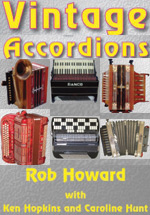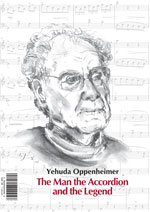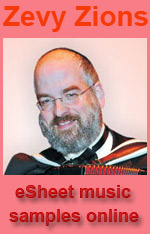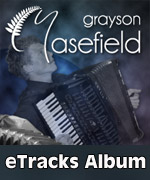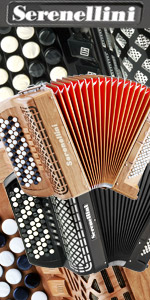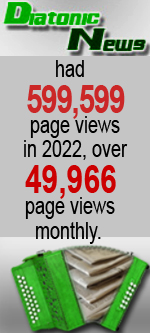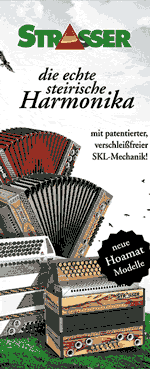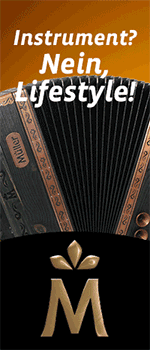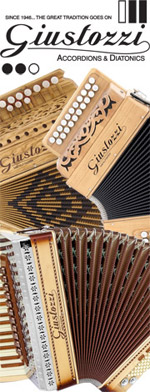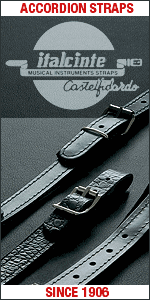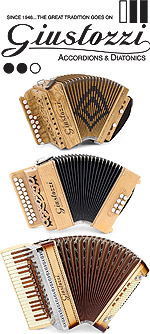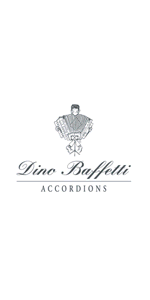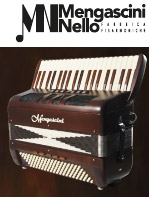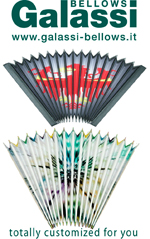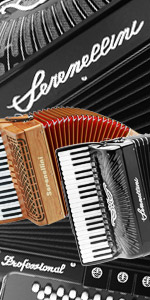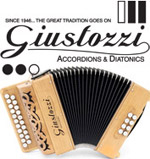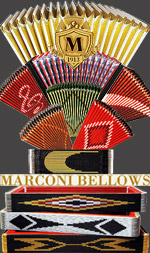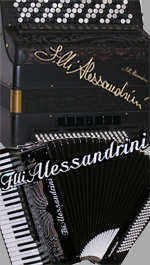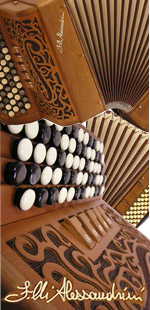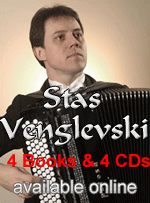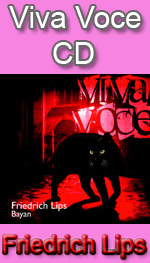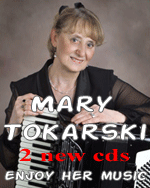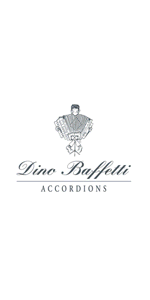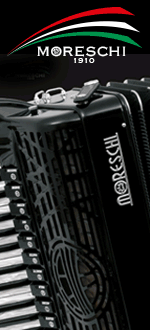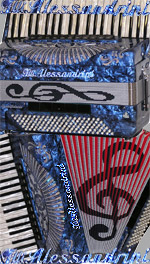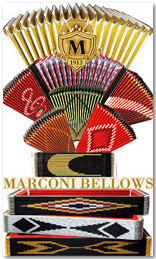
Highlights |
LA FISARMONICA DIATONICA NELLA DIDATTICA MUSICALE DI BASE - Italia
18°Campionato del Mondo Organetto/Fisarmonica Diatonica - Italia
40. Festival Interceltique in Lorient - France
Begriffsverwirrungen bei der Steirischen Harmonika - Austria
Das Harmonikazentrum Graz - Austria
COMPOSING TUNES FOR DIATONIC ACCORDION - Cyberspace

Festivals, Competitions, Masterclasses/Seminars/Stages, Reports etc. |
Impressionen vom Tag der Harmonika, 13. Juni 2010 - Rottenmann/Austria
Festival Acadien de Clare - Canada
Texas Creole Music Festival - USA
Stage di organetto diatonico a Maresca - Italia
Jyderup Harmonikafestival - Denmark
Dublin Irish Festival/Ohio - USA
Festival San Flora - Italia
16° FESTIVAL DI MUSICA POPOLARE - Italia

Future events / Concerts |
Riccardo Tesi/Banditaliana Tour in August - Italy/Germany
Le Ciaramelle d'AMATRICE/Rimini al 8 Agosto 2010 - Italia
Musikantentreffen in Mùnchen - Deutschland
Majella (PE) Etno Festival 6-7 AGOSTO - Italia

CD/VIDEO/Book (New/Reviews/Presentations) |
2 CD par Yann-Fañch Perroches - France
Help Desk, Information needed, Readers CommentsSubmit Your Question, CommentSUBMIT NOW |

Highlights |

Accordion Yellow Pages/Events - CYBERSPACEby Harley Jones |
 All concert, competition and festival organizers are reminded to list their Future Events in our yellow pages website. Its free to list and you can do it yourself. You can also change and update your listing yourself as further information becomes available. All concert, competition and festival organizers are reminded to list their Future Events in our yellow pages website. Its free to list and you can do it yourself. You can also change and update your listing yourself as further information becomes available.The accordion yellow pages Future Events calendar displays at the top right hand side of this Weekly News of accordions.com in all 7 languages plus other popular sites such as the USA News and the Diatonic News. Huge numbers of readers every year view the accordion yellow pages Future Events, so all accordion event organizers are urged to take full advantage of this free service to keep the accordion community informed. German Alle Akkordeon-Konzert sowie Wettbewerbs- und Festival-Organiatoren möchten wir daran erinnern, alle bevorstehenden Veranstaltungen in den aktuellen Akkordeon-Gelben Seiten, www.accordion-yellowpages.com Webseite einzutragen. Alle Einträge sind kostenfrei und können direkt online selbst auf die Seite gestellt und aktualisiert werden. Bereits bestehende Informationen sollten auf ihre Richtigkeit und Gültigkeit geprüft werden Alle Veranstaltungen sind in unseren Eventkalender ersichtlich und dies auf allen unseren 7 übersetzten Sprachen. Der Event-Kalender ist gelb und auf der rechten Seite/oben auf unseren verschiedenen Seiten zu finden. Dies inkludiert unsere USA Nachrichten Edition accordions.com und das neue Portal, das den diatonischen Instrumenten gewidmet ist - diatonische-news.com Eine große Anzahl von Lesern konsultieren täglich, wöchtenlich, monatlich, jährlich unsere Akkordeon-Yellow Pages Future Events Seiten. Nützen Sie diese Gelegenheit – es ist ein kostenloses kostenlosen Service für die Akkordeon Gemeinschaft. Italian Tutti gli organizzatori di concerti, concorsi e festival devono ricordarsi di inserire i loro eventi futuri nel sito Accordion-YellowPages.com. La segnalazione è gratis e potete farlo autonomamente. Potete cambiare e aggiornare il vostro annuncio da soli e far rendere l'informazione disponibile. La voce Eventi Futuri si trova in alto sul lato destro delle notizie di accordions.com in 7 lingue più altri siti come accordionsusa.com e diatonic-news.com. Un enorme numero di lettori visiona le pagine di Accordion Yellow Pages Future Events ogni anno, così prende tutto il vantaggio di questo servizio gratis per la comunità fisarmonicistica. French Tous les organisateurs de concerts, de festivals et de concours sont rapplelé d'insérer leurs événements à venir sur le calendrier du site Accordéon-YellowPages.com. L'insertion est gratuite et vous pouvez le faire individuellement. Vous pouvez modifier et mettre à jour votre annonce par vous-même et de rendre l'information disponible. Le calendrier des Événements à venir est sur le côté supérieur à droit des nouvelles hebdomadaire en 7 langues du accordions.com et que accordionsusa.com et diatonique-news.com. Un grand nombre de lecteurs consultes les pages jaune de l'Accordéon pages chaque jour et année est surtous l’ événements futures, profiter pleinement de ce service gratuit pour la communauté des accordéonistes. |

LA FISARMONICA DIATONICA NELLA DIDATTICA MUSICALE DI BASE - Italiaby Holda Paoletti-Kampl |
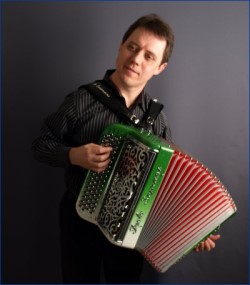 LA FISARMONICA DIATONICA NELLA DIDATTICA MUSICALE DI BASE di Alessandro Mugnoz LA FISARMONICA DIATONICA NELLA DIDATTICA MUSICALE DI BASE di Alessandro MugnozOgni musicista/docente sa che non esiste lo strumento musicale “perfetto”: ogni macchina per far musica, antica o moderna, ha inevitabilmente i suoi limiti (o le proprie mancanze). Esistono piuttosto, nell’attuale pratica musicale, strumenti che per varie ragioni - storiche, culturali, sociali e di mercato - hanno più o meno “fortuna”, trovando maggiore o minore impiego nei vari settori musicali… compresa la didattica. C’è poi da dire che l’odierno mondo culturale, non solo musicale, tende sempre più ad etichettare (e a dividere/separare) tutto, quindi anche gli strumenti musicali: “nobili” e “popolari”, classici ed etnici… ecc. (senza peraltro approfondirne adeguatamente l’evoluzione storica e i relativi repertori). Nel settore della didattica musicale di base possiamo osservare due tronconi principali: 1°) la propedeutica e le classi di “Educazione musicale”, oltre ai vari “Laboratori” (più o meno sperimentali) nella Scuola dell’obbligo - 2°) i primi corsi (o livelli) delle Scuole pubbliche e private; incluse quindi le Scuole Medie ad indirizzo musicale e gli attuali “Corsi di base”, o “pre-accademici”, dei (ex) Conservatori. Nel 1° filone viene principalmente impiegato il cosiddetto “strumentario Orff”, costituito in massima parte da piccoli strumenti a percussione, il flauto dolce, la “clavietta” (o melodica) e la “tastiera elettronica” (strumento che andrebbe maggiormente valorizzato e utilizzato). Mentre nel 2° troviamo soprattutto i soliti: pianoforte (acustico e digitale), chitarra (classica ed elettrica), flauto e, in seconda battuta, clarinetto, sassofono, violino, ecc. Dopo questa necessaria premessa, ed in base alla personale e ormai trentennale esperienza professionale, a vari livelli e con diversi incarichi (avendo avuto la possibilità di insegnare differenti strumenti a tastiera), posso tranquillamente affermare che tra gli strumenti pedagogicamente più funzionali alla didattica musicale di base, sin dai primi approcci con il mondo delle sette note, c’è sicuramente da includere anche la tradizionale fisarmonica diatonica., la quale si rivelerebbe preziosa sia in un generico ambito di educazione musicale/strumentale (e di musica d’insieme), sia nel più specifico settore della pratica strumentale specialistica, anche propedeutica ad eventuali altri (successivi) strumenti… “più complessi”. Proverò ad esporre sinteticamente le ragioni di questa affermazione, citando prima le caratteristiche salienti dello strumento. La fisarmonica diatonica, in alcuni casi detta anche organetto, è uno strumento – appartenente alla famiglia degli aerofoni , a mantice e ad “ancia libera” – che da vari anni sta vivendo una felice stagione di (crescente) riscoperta. È uno strumento già dotato di una certa metodologia didattica (che parte dagli anni ’30 dell’ottocento), attualmente confinata però quasi esclusivamente nel mondo del folk, ovvero della musica popolare/etnica. Uno strumento caratterizzato da moltissimi modelli e “sottomodelli”, dislocati/impiegati in ogni parte del mondo; nelle sue forme più semplici produce suoni in una sola o in pochissime tonalità. È piuttosto leggero e maneggevole, essendo di dimensioni contenute, quindi estremamente portatile. Si tratta in effetti di uno strumento con vari limiti: usato principalmente, come già accennato, quasi esclusivamente nella musica popolare o nella world music; la sua letteratura originale (scritta) è piuttosto esigua e per di più frammentata, secondo i vari modelli per i quali è stata concepita; possiede poche note, essendo strumento fondamentalmente diatonico, quindi di estensione contenuta (almeno nei “modelli base”); è “bitonico” - un po’ come l’armonica a bocca -, ossia ogni tasto/bottone generalmente produce due note (o due accordi), obbligando spesso l’esecutore a continui cambi di direzione del mantice. Ebbene proprio questi “limiti” costituiscono la “forza” e il valore di questi strumenti. - Il fatto che sia stato (democraticamente) usato soprattutto nella musica popolare/etnica lo rende molto adatto a una didattica di base, sin dai corsi propedeutici, proprio perché una sana e corretta educazione musicale dovrebbe poggiare principalmente sui “canti popolari”… e le esperienze pedagogiche (in senso lato) più importanti, oltre che le tendenze più aggiornate, lo confermano ampiamente. - La sua struttura fonica è si costituita da (relativamente) poche note/tasti – basandosi su una o comunque poche tonalità – ma è d'altronde un “piccolo condensato” di storia, teoria ed armonia musicale; prendiamo ad esempio uno strumento a due file - in sol/do - e otto “bassi” (considerato generalmente il modello più diffuso): può suonare nelle scale diatoniche maggiori di do e sol - e nelle relative minori - con la possibilità di modulare alla dominante e alla sottodominante; i suoi sei bassi fondamentali, ovvero i primi sei gradi della scala naturale (l’esacordo di Guido d’Arezzo), con le relative armonie (triadi) maggiori e/o minori “precostituite”, ossia già predisposte sotto un unico tasto/bottone, garantiscono sinteticamente un “gioco” cha può andare dal più semplice accompagnamento al più complesso schema ritmico-armonico; oltre alla possibilità di creare/eseguire contrappunti (più o meno semplici, a 2-3 voci) tra le due tastiere. Tutto ciò (e altro ancora!) rende lo strumento un efficace mezzo per iniziare a studiare l’immenso patrimonio di musica tonale (popolare e colta) sviluppatosi nella nostra cultura occidentale ma, ancor più, gli permette di essere il mezzo ideale per iniziare a sviluppare la creatività musicale: la composizione e l’improvvisazione, oltre alle consuete “abilità interpretative”, proprio a partire dai “codici” radicati nella nostra civiltà musicale! - L’essere bitonico e quindi “obbligando” a frequenti inversioni di mantice, costituisce a ben vedere un ottimo esercizio pedagogico; infatti “stimola” l’allievo, sin dall’inizio, a prendere coscienza e quindi a padroneggiare il “polmone” del proprio strumento, ovvero il mezzo che (similmente all’archetto del violino) gli potrà garantire: espressività, dinamica e personalità musicale. - Il fatto di non avere un’importante (e riconosciuta) letteratura musicale, anche didattica, rende l’impiego dello strumento libero da un possibile “peso vincolante” del passato – come una sorta di terreno vergine ancora da esplorare e sfruttare… - Le sue dimensioni contenute e la relativa leggerezza, oltre a favorire una notevole espressività nella condotta del mantice, ovviamente lo rendono un mezzo congegnale anche per i primi approcci alla musica, fin dalle scuole materne. - In relazione al punto precedente, si riscontra poi una relativa “leggerezza” nel prezzo di vendita (anche se qui le aziende produttrici potrebbero fare di più!). Questo può essere un ulteriore punto di forza, almeno rispetto ad altri strumenti acustici a tastiera. - La portabilità, oltre alle caratteristiche già citate, rende lo strumento utilissimo e particolarmente adatto per le varie attività di “musica d’insieme” e per un felice impiego nei “corsi collettivi” (laboratori, ecc.). La sua versatilità gli permette di costituire vari gruppi monostrumentali (a tre, quattro, cinque parti), ma anche l’inserimento in vari ensemble, nelle più diverse combinazioni di strumenti, potendo inoltre sostituire o raddoppiare sia gli archi (ad es. il violino o la viola) che i fiati (ad es. l’oboe, il corno inglese o il clarinetto). Concludendo, la fisarmonica diatonica ha in sé le riconosciute e apprezzate caratteristiche polifoniche degli strumenti a tastiera ma, essendo un aerofono, possiede pure la notevole espressività degli strumenti a fiato; inoltre l’appropriato uso del mantice, molto sensibile e dinamico (similmente ai “colpi d’arco” del violino), lo avvicina anche agli accenti e alle sfumature degli archi. Di fatto può essere uno strumento perfettamente “solista”, ma anche un ottimo strumento “d’accompagnamento” oppure efficacemente inserito in qualsiasi ensemble/orchestra. In definitiva uno strumento musicale per molti aspetti ancora “inesplorato”; da ri-scoprire e rivalutare, partendo proprio da un adeguato ed auspicabile impiego nella didattica musicale di base. |
 |

18°Campionato del Mondo Organetto/Fisarmonica Diatonica - Italiaby Holda Paoletti-Kampl |
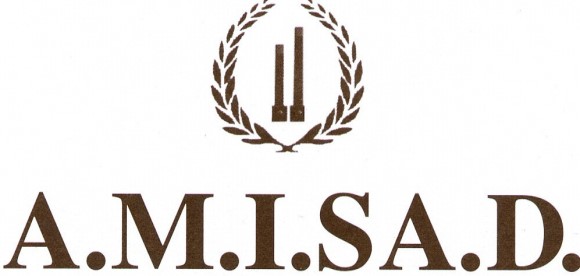 |
| Roccagorga (LT) - ITALY - 17–18–19 agosto 2010 Il Comune di Roccagorga (LT) - ITALIA - in collaborazione con l’Associazione Musicale Italiana Strumenti ad Ancia, Diatonici (A.M.I.S.A.D.) di Maiolati Spontini (AN) - ITALIA - organizza la 18° Edizione del Campionato del Mondo di Organetto e di Fisarmonica Diatonica. Alla competizione potranno prendere parte solo concorrenti selezionati e quelli aventi diritto: - Campioni del Mondo di Organetto-Fisarmonica Diatonica - Campioni Europei di Organetto e Fisarmonica Diatonica - Campioni Nazionali di Organetto e Fisarmonica Diatonica - Campioni Italiani Junior e Senior -Edizione 2010- di Organetto e Fisarmonica Diatonica e i classificati 1 Premio delle rispettive Sezioni e categorie. - Candidati selezionati in altri Concorsi Nazionali o Internazionali Info A.M.I.SA.D. (Ass. Musicale Italiana Strumenti ad Ancia, Diatonici) Via G. Pascoli,1bis 60030 Maiolati Spontini (AN) – ITALIA Info per e-mail : roncogia@libero.it English 18TH Accordion-Diatonic Accordion World Championship The Comune of Roccagorga (LT) ITALY together with A.M.I.S.A.D. (Associazione Musicale Italiana Strumenti ad Ancia, Diatonici) di Maiolati Spontini (AN) – ITALIA – is organizing the 18TH Accordion-Diatonic Accordion World Championship. - Accordion-Diatonic Accordion World Champions - Accordion-Diatonic Accordion European Champions - Accordion-Diatonic Accordion National Champions - Junior and Senior Italian Champions – Edition 2010 of Accordion-Diatonic Accordion and first prize graded of the respective sections and categories - Candidates selected in other national or international contests. Info: A.M.I.SA.D. (Ass. Musicale Italiana Strumenti ad Ancia, Diatonici) Via G. Pascoli,1bis - 60030 Maiolati Spontini (AN) – ITALIA Email contact : roncogia@libero.it |

40. Festival Interceltique in Lorient - Franceby Holda Paoletti-Kampl |
 |
| Festival du 6-15 Aout! vendredi 13 août 15H00 n°44 Palais des Congrès Troph. Interceltique d'Accordéon Diatonique Further Inforamtion: http://www.festival-interceltique.com/programmation/ Pour plus d’information visiter http://www.festival-interceltique.com/programmation/ Le Festival Interceltique de Lorient vous accueille au 11 Espace Nayel à Lorient (56100) Vous pouvez téléphoner : Accueil : 02 97 21 24 29 Fax : 02 97 64 34 13 Billetterie : 02 97 64 03 20 Online translation ! |

Begriffsverwirrungen bei der Steirischen Harmonika - Austriaby Werner Weibert |
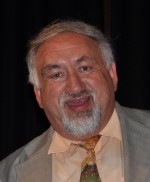 Aus gegebenem Anlass weist Mag. Johann Murg auf eine Thematik hin, die immer wieder ein Chaos bei der Einstufung der Wettbewerbsstücke für den Harmonikaverband Österreich verursacht. Nämlich, die Bassbezeichnung in Griffschrift für die Steirische Harmonika. Eine Bereinigung wäre sehr wünschenswert und notwendig – im Interesse des Instruments und auch der Spieler! Aus gegebenem Anlass weist Mag. Johann Murg auf eine Thematik hin, die immer wieder ein Chaos bei der Einstufung der Wettbewerbsstücke für den Harmonikaverband Österreich verursacht. Nämlich, die Bassbezeichnung in Griffschrift für die Steirische Harmonika. Eine Bereinigung wäre sehr wünschenswert und notwendig – im Interesse des Instruments und auch der Spieler!Bei der Begutachtung der Pflichtstücke und Wahlstücke ist man immer wieder mit dem Problem konfrontiert, die Buchstabenbezeichnung mit den tatsächlichen Bass- und Akkordtönen der Klangschrift zu identifizieren. (Meist fehlen die dazugehörenden Legenden.) So ist es oft nicht möglich, festzustellen, ob das Geschriebene mit der korrekten Harmonie des Stückes übereinstimmt, wie Mag. Murg ausführt: „Daher will ich nun einige Varianten von Bassbezeichnungen der Steirischen Harmonika aufzeigen. a) Als erstes Beispiel möchte ich die Bezeichnung nach Max Rosenzopf anführen, der für die 1.Reihe (äußere Diskantreihe) für den Bass die Buchstaben A, a, B, b, 2.Bassreihe: D, d, (Balgseite) C, c, 2.Bassreihe: G, g, 4rhg: F,f, E, e, (oder H,h,) verwendet. Beim vierreihigen Modell kommt noch eine 2.Variante hinzu, bei der die Bezeichnung D,d, noch mit dem E,e-Bass vertauscht werden kann. Auch unterschiedliche Harmoniefunktionen können laut Spielanleitung hinzukommen. Nach Rosenzopf hat sich die Bauweise so etabliert, dass auf der 2.Bassreihe für die 2.Tonart auf Druck die Terz in Dur und auf Zug in Moll erklingt. Für die 3.Diskanttonart erklingt auf der 2.Bassreihe der Terzbass auf Druck, ebenfalls in Dur, u. auf Zug in der Subdominante. Manche Instrumentenbauer bauen statt Vorgenanntem auch auf Zug in Moll ein. Diese Unterschiede sind aber in der Griffschriftbezeichnung nie erkennbar und es ist somit auch nicht feststellbar, ob gegebene Passage harmonisch richtig erklingt. b) Als weiteres Beispiel wäre die Bezeichnung von Florian Michlbauer, der wie folgt die Bassbezeichnung vornimmt, zu nennen. X, A,a, H B,b, G,g, C,c, F,f, D,d, E,e, Er verwendet noch als weitere Spezifikation das Moll-System auf Zug für die 2.u.3. Diskant-Reihe auf der 2.Bassreihe. c) Das nächste Beispiel wäre die Notation von Gottfried Kletzmair. Er bedient sich des Quintenzirkels und verwendet diesen auf Druck und Zug gleich, wobei die harmoniegerechte Funktion auch nicht gegeben ist. G,g, W, C,c, E,e F,f, A,a B,b, D,d d) Cornelia Schaborak u Hans Auer wiederum schreiben den Bass nach dem Alphabet nieder und geben bei der 2.Bassreihe ein Apostroph dazu. Auch hier kann man keine Harmonieform erkennen. A,a, A´,a´ B,b, B´,b´, C,c, C´,c´, D,d, D´,d´, e) Hermann Huber verwendet auch noch einen Bass „O“, der als Wechselbass für die 1.Reihe gespielt wird. Auf der 2.Bassreihe wird dieser Zusatzbass mit „O´“ bezeichnet. Zusätzlich unterscheidet sich die Anordnung noch dadurch, dass beim Hubermodell auf Druck die Mollbässe mit den Mollakkorden erklingen. f) Als weiteres Kuriosum konnte ich bei der Durchsicht der Noten eine Bassbezeichnung, wie folgt, von Erich Pauli entdecken. Er bezeichnet die Bässe mit einem „2er“ für die 2.Bassreihe. Aa, A2, Bb, B2b2, Cc, C2c2, Dd,, D2d2, g) Karl Kiermaier und Egon Spengler schreiben die Bässe und Akkorde wie nachstehend nieder. AW Aa AW Bb Dd Cc Gg Ff Hh Kk Mm Dies sind einige Beispiele, die keine befriedigende Lösung in der Bassbezeichnung darstellen. So konnte ich auch bei den Wertungsspielen oft andere Töne hören als die Bassbezeichnung anzeigte, die anscheinend durch einen gewünschten Umbau des Instruments, speziell für den jeweiligen Spieler, vorgenommen wurden. Auch die Notation der Diskanttöne hat bereits schon viele verschiedene Formen für das Griffschriftbild angenommen und führt zu Unübersichtlichkeiten. Kompliziert wird die Sache dann, wenn mehrere Töne auf der gleichen Linie notiert werden müssen. Da schaut die Angelegenheit aber schon sehr unübersichtlich aus. Den Akkorden kann man nicht auf Anhieb folgen. Diesem Thema möchte ich mich aber in einem nächsten Bericht widmen. Resümee: Würde man nach dem Violinschlüssel und Bassschlüssel, dessen Verfechter ich bin, das Instrument erlernen, hätte man all diese Irritationen der Notation aus der Welt geschafft. Nach all diesen verschiedenen Notationen wäre es sinnvoll, wenn sich vorgenannte Autoren zusammensetzen und eine einheitliche Notation für die Zukunft anstreben würden. Mag. art. Johann Murg - Fachvorstand für Steirische Harmonika (Harmonikaverband Österreichs)“ Online translation ! |

Das Harmonikazentrum Graz - Austriaby Wolfram Maerzendorfer |
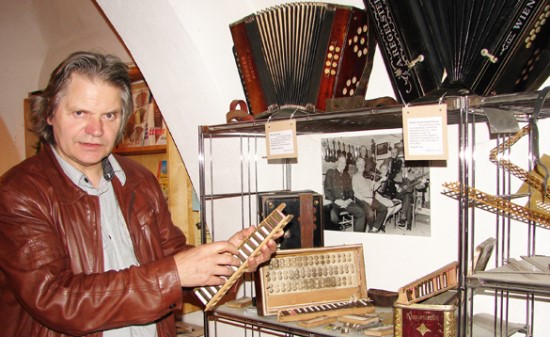 |
 Regelmäßig ladet das Harmonikazentrum Experten zu Vorträgen ein. Inhaltlich handelt sich dabei um die Vorstellung einzelner Instrumententypen wie zum Beispiel dem Schwyzer Örgeli, dem Bandoneon oder der Wiener Schrammelharmonika. Auch pädagogische Themen sowie rein bau- und stimmtechnische Details können Inhalt eines Vortragsabends sein. Regelmäßig ladet das Harmonikazentrum Experten zu Vorträgen ein. Inhaltlich handelt sich dabei um die Vorstellung einzelner Instrumententypen wie zum Beispiel dem Schwyzer Örgeli, dem Bandoneon oder der Wiener Schrammelharmonika. Auch pädagogische Themen sowie rein bau- und stimmtechnische Details können Inhalt eines Vortragsabends sein.Über die Forschung hinaus hat man großes Interesse am lebendigen Kontakt mit der Laienszene der Harmonikaspieler. Kein anderes Instrument kennt so viele Liebhaber, Spätbeginner, Bastler und Sammler. Auch das ist eine wahre Fundgrube an verschüttetem Wissen das aufgesammelt wird. War es noch vor wenigen Jahren schwierig und oft dem großen Zufall überlassen an Informationen zu gelangen so verspricht das Medium Internet ganz neue Möglichkeiten des Austausches, Vergleiches und der Übersicht hinsichtlich vorhandener Materialien zur faszinierenden anarchischen Geschichte des Instrumentes. Es ist anzunehmen, dass man trotz der Informationsflut in den letzten Jahren hier noch ganz am Anfang steht. Es müssen erst Mechanismen und Methoden entwickelt werden um die Flut an Bildern und Beiträgen zu kanalisieren. Jedes Angebot zur Kooperation und jeder neue Kontakt wird dankbar angenommen. Alle zwei Jahre findet ein kleines Akkordeonfestival nahe bei Graz statt und so auch dieses Jahr zwischen dem 8. und 10. Oktober. Die Mitwirkung italienischer Mundharmonikaspieler im Jahr 2006 ist noch in eindrucksvoller Erinnerung. Nähere Informationen zum heurigen Festivalprogramm finden Sie unter www.promonica-west. at oder www.harmonikazentrum.at oder via e-mail wolfram.maerzendorfer@utanet.at Online translation ! |
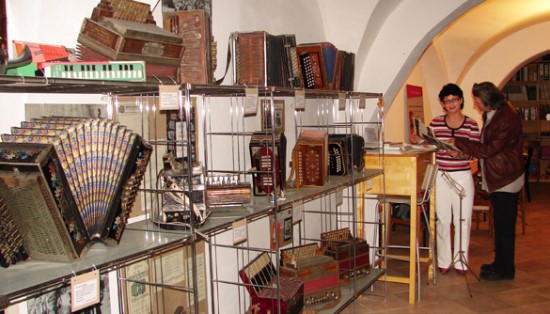 |

COMPOSING TUNES FOR DIATONIC ACCORDION - Cyberspaceby Holda Paoletti-Kampl |
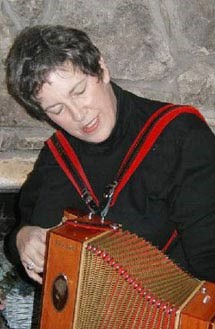 COMPOSING TUNES FOR DIATONIC ACCORDION...an interesting article by K a y H i c k m a n. COMPOSING TUNES FOR DIATONIC ACCORDION...an interesting article by K a y H i c k m a n.There are many reasons for one to compose his/her own tunes. Somebody has composed every tune you play. It’s enjoyable to learn someone else’s tunes, but it’s even more enjoyable and more satisfying to create your own tunes. It’s not that difficult to do if you take it all one step at a time. In order to compose, it does make it easier if you have some skill with the accordion and if you don’t know what note each button is, it’s good to have an idea of how the keyboard is set up. It’s important to listen to a lot of tunes from different countries and get a handle on what is the same in the tunes. For instance, Scandinavian tunes. Most of the time it is very easy to tell, just by listening, if a tune is from one of the Scandinavian countries. Most of them have a specific Scandinavian flavor. One row Quebec tunes also have their own flavor. Breton tunes have a certain sound also. And so do Basque tunes. If you want to compose a Basque tune, then listen to hours of Basque music and notice what is the same about a lot of the tunes. Or French music - listen to a lot of different composers and musicians and tunes. Some tunes could be composed as a tribute to someone. When doing this, think about the person you want to pay tribute to. What type of person is this - what is the personality? What type of tune would this person like to have connected to them? I wrote a tune for a friend in France, and I knew ahead of time that it couldn’t be a slow pretty waltz, as he hated them. So I composed a fast polka with a very pretty sound that I thought he might like to play also. I composed a tune for my accordion maker, and I think of him as a happy positive thinking man - so the tune had to sound that way. When I composed a tune for his lady friend, I had sad thoughts because she is ill and not able to enjoy life as she should be able to do, and so I composed a minor sad sounding waltz for her. A lot of composing comes from just “messing around” with the accordion - playing around with no real tune in mind - just hitting notes. All of a sudden there is a riff - a measure or two that sounds good. That’s one way to get started. Take some paper and write down the riff you just played, so that you won’t forget it. You don’t have to write a tune right then. You can just write down a riff whenever one comes. Keep a notebook for writing music. Preferably one that will lay open easily and always start a tune on the left side so that if it becomes a long tune, you’ve got two pages to write on and you won’t have to turn a page. I have several notebooks in different places in the house for when an idea comes. I used to just remember all my tunes and play them from memory. I would quickly record them so that I would not forget them. I have found that ones I did not record quickly and did not play enough, have already been forgotten and lost forever. To keep that from happening, write them down. Keep a pencil handy - not a pen. There might be a lot of erasing. I was ill with phlebitis for 3 weeks last June, and stuck in a chair with my leg up. There was nothing wrong with my hands and my brain though, so it was a good time to compose. I had peace and quiet and managed to write and record 25 tunes. It was a conscious effort to compose. Instead of noodling around with the accordion, I decided I would compose at least a tune a day. I stopped listening to any other music so that I could concentrate on my own music. The flow of the tune is very important. You must also make the decision as to how many parts the tune will have and in what order the parts will be played. Diatonic accordion tunes tend to be shorter than other tunes and the order in which the parts flow can make a difference in the tune itself. For instance, a tune with 3 parts could be played as ABCABC or AABBCC or ABBCACB - or whatever way works best. I have found that it takes some thought when writing tunes. If the bellows is all the way out and can go no further easily - then I have to come up with something that takes my bellows in. In writing different parts, I like to make each part end a certain way and begin a certain way so that they can be interchanged andflow easily. If basses are also to be used in the tune, then they must be added in immediately when composing the tune. It is not as important if the basses are set up unisonorously. If they are regular diatonic basses, then they absolutely must be added in when first starting - to get the treble to work correctly with the basses. This is probably the most difficult part of composing a tune for a diatonic accordion. You must figure out the basses quickly, because depending on what the bass note needs to be - you may have to find the same note on the treble side going in instead of out or vice versa. Naming a tune that has no words is much more easy than putting basses to the treble side. If you are composing a tune in honor of someone, then you can name it Tribute for Emily or Emily’s Waltz. If you compose a tune and have no idea what to name it, just think about it for a bit, and something will pop into your head. There are several different ways to write tunes for diatonic accordion in tablature. Choose the system that works best for you, or make up your own system. You can use tablature paper or just use notebook paper. I normally just use a notebook. I use three lines to write tablature. On the left side of the paper I write Push on the first line, Pull on the second line, and Bass on the third line. This is how I do it, but you write it out the way that works best for you. Record your tunes with a home recording device (minidisc recorder or whatever you use) so that the feel to the music is there, since it doesn’t show up in tablature. You can also use the software program “tabledit” or another program, to put your tunes into tablature so that it can be easily shared with other folks. Have fun with composing. Copywrite your tunes. Share your music with everyone - that’s how we get more tunes! Online translation ! For further information upon KAY HICKMAN view http://www.streetsqueeze.com/ |

Festivals, Competitions, Masterclasses/Seminars/Stages, Reports etc. |

Diatonic Festival - Calabria/Italiaby Holda Paoletti-Kampl |
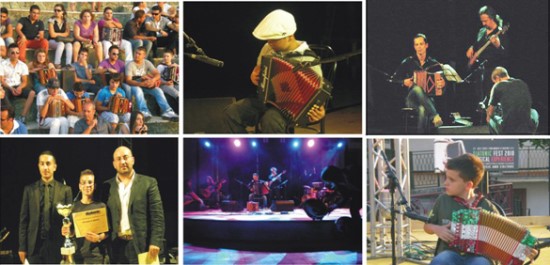 |
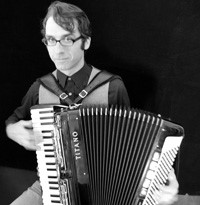 DIATONIC FEST Festival and Iternational Competition , conservatorio di musica "P.I. Tchaikovsky" Calabria (IT) DIATONIC FEST Festival and Iternational Competition , conservatorio di musica "P.I. Tchaikovsky" Calabria (IT)Si è conclusa brillantemente il 23 luglio la 2a edizione del Diatonic Fest, la competizione internazionale promossa dal Conservatorio di Musica Tchaikovsky e dal comune di San Mano d’Aquino, con il supporto della Casa delle Culture “M.Coltellaro”. L'Anfiteatro Comunale di San Mango ha fatto da cornice a questa straordinaria manifestazione con un pubblico di oltre 1500 presenze e oltre 100 i partecipanti al Concorso. Numeri che fanno del "Diatonic Fest" il più importante concorso Nazionale per questo strumento e fra i primi a livello Europeo. I concorrenti si sono sfidati di fronte a una competente giuria, presieduta da Giuseppe Scigliano, la quale ha infine decretato Guglielmi Alessandro come vincitore assoluto del Diatonic Fest 2010, il quale ha ricevuto il premio da Saveria Rizzuto, presidente dell’Associazione “M.Coltellaro”. Il premio speciale “Tommasino Maletta”, come migliore composizione originale, è stato invece assegnato a Di Prospero Matteo. L'iniziativa fortemente voluta dal conservatorio di musica "P.I. Tchaikovsky" , ha visto la presenza di prestigiosi nomi del panorama mondiale. « La seconda edizione del festival rappresenta la continuità di un progetto di valorizzazione del territorio e degli strumenti cosiddetti popolari - ha dichiarato il direttore del conservatorio maestro Pierfrancesco Pullia - sul modello del conservatorio di musica "A. Casella" dell'Aquila, sarà nostra intenzione promuovere un corso di studio proprio per questo strumento e al contempo, così come previsto dalle nostre finalità statutarie, attivare un importante centro di ricerca sulle musiche e tradizioni popolari del Mediterraneo». Per queste ragioni il Conservatorio Tchaikovsky, ente comunemente preposto alla formazione musicale cosiddetta colta, ha scelto di intraprendere questo percorso alternativo, facendosi sostenitore di un festival, dedicato all'organetto, che promuoviamo quest'anno in questa seconda edizione e che ci auguriamo possa crescere e migliorare negli anni futuri. Info. +39 0968 923854 - +39 347 9020512 www.diatonicfest.com www.altaformazionemusicale.it |
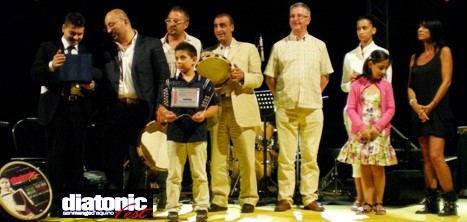 |

Impressionen vom Tag der Harmonika, 13. Juni 2010 - Rottenmann/Austriaby Werner Weibert |
 |
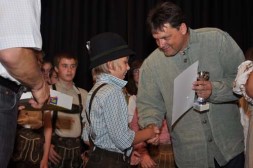 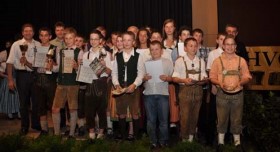 Das Übersbacher-Duo (Gewinner Duo B) beim Festkonzert (oben) Das Übersbacher-Duo (Gewinner Duo B) beim Festkonzert (oben)Rottenmanns Bürgermeister Ewald Persch bei der Preisübergabe (links) Der Veranstalter Prof. Siegfried Greimler mit den Preisträgern (rechts) Alle Kandidaten auf der Bühne mit dem HVÖ-Präsidenten Werner Weibert (unten) Online translation ! |
 |

Festival Acadien de Clare - Canadaby Holda Paoletti-Kampl |
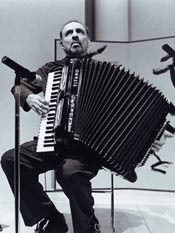 |
| Le Festival acadien de Clare est le plus ancien festival acadien au monde et a toujours été une célébration de la culture et du patrimoine acadien. Des milliers de gens de partout au monde se réunissent chaque année à la Baie Sainte-Marie pour une quinzaine de jours pleins d'activités variés pour les gens de tous âges. Une série de spectacles musicaux ont lieu à toutes les années avec de la musique acadienne, cadienne, et bluegrass. Des expositions d'art et de couvertes piquées démontrent les talents des gens de la région et les activités aux endroits divers permettent aux gens de visiter la région au complet. De plus, les gens peuvent démontrer leur créativité et leur fierté lors du défilé annuel (qui a lieu la première fin de semaine du Festival) et du Tintamarre (qui a lieu le 15 août) et où tout le monde est invité à venir célébrer la fierté acadienne! Des nouvelles activités se rajoutent au programme à chaque année et tout le monde est invité d'y participer. On espère vous y retrouver! Le Festival acadien de Clare (du 29 juillet au 15 août 2010) est le plus ancien festival acadien au monde et a depuis toujours été une célébration de la culture et du patrimoine acadiens. Plusieurs heures de planification et d'organisation sont nécessaires pour préparer cet événement qui comprend de multiples activités pour répondre à tous les goûts et à tous les âges. Le festival s'adresse autant aux touristes d'ailleurs qu'aux Acadiens de la Baie qui y demeurent et qui reviennent chaque année pour leurs vacances d'été. Depuis le Congrès mondial acadien de 2004, le comité organisateur du festival acadien a attiré au sein de son équipe de nombreuses personnes dévouées qui ont à cour de travailler ensemble pour rehausser la diversité et la qualité des activités de leur festival. Vous trouverez encore cette année une grande variété d'activités traditionnelles comme le choix de Gabriel et d'Évangéline, les messes, le défilé, le concours de bûcherons et le bazar populaire qui réunit sur le campus de l'université, après le défilé, la grande majorité des Acadiens de la municipalité. Des spectacles en plein air de grande envergure ponctuent les trois fins de semaine du festival avec de la musique acadienne, de la musique cadienne et de la musique bluegrass qui ont toujours eu une influence marquante sur la création musicale de la Baie. En 2006, en plus de mettre en vedette les groupes professionnels de la Baie, nous accueillerons quelques grands noms de groupes acadiens, surtout du Nouveau-Brunswick, et de la Louisiane. D'autres spectacles qui mettent en valeur la parole, la nourriture, la musique, le théâtre et la danse auront lieu dans diverses salles de la communauté. Le festival offre aussi une journée porte ouverte des nombreuses galeries d'art de la région, une merveilleuse exposition de courtepointes, ainsi que des excursions sur terre et sur mer qui mettent en valeur la nature omniprésente à la Baie Sainte-Marie. Les deux semaines remplies d'activités se termineront le 15 août (journée Nationale des Acadiens) avec un Tintamarre bruyant, un défilé d'autos et de personnes. Le festival acadien de Clare allie fort bien le traditionnel et le moderne. Toutefois, son plus grand atout pour les visiteurs demeure l'accueil chaleureux des Acadiens. Plus d'information: http://www.festivalacadiendeclare.ca/ The Festival acadien de Clare is the oldest Acadian festival in the world and has always been a celebration of Acadian culture and heritage. Thousands of people from all over the world gather every year in the Baie Sainte-Marie region for over two weeks filled with plenty of activities for people of all ages. A series of musical concerts take place every year and feature many musicians from all over the world and music genres such as Acadian, Cajun and Bluegrass. Art expositions and a quilt display show off the talent of local artists and the activities located all around Clare give people the opportunity to visit every part of the beautiful region. Also, anyone can show off their pride and creativity during the annual parade (that takes place on the first weekend of the festival) and the Tintamarre (that takes place on August 15th) and where everyone is invited to celebrate the Acadian pride! New activities are added to the program each year and everyone is encouraged to come participate. We hope to see you there! The Festival acadien de Clare (from July 29th to August 15th, 2010) is the oldest Acadien festival in the World and has always been a celebration of culture and heritage for Acadians. Many hours of planning and organising are necessary to prepare this event, that includes multiple activities that answers to all tastes and age groups. The Festival is both for visitors and local Acadians who still live here as well as those who have moved away and return each year during their summer vacations. Since the 2004 World Acadian Congres, the organising committee of the Festival acadien is composed of people who are dedicated to working together at increasing the diversity and quality of the Festival's activities. You'll find this year, once again, traditional activities such as the selection of Gabriel and Évangéline, masses, parades, lumberjack competition and the very popular bazaar that reunites everyone on the campus of Université Sainte-Anne. Concerts that are held under a large tent at the Club social de Clare are highlights during the three festival weekends. These concerts include traditional Acadian music, Cajun music, contemporary music and Bluegrass that has always influenced music here at Baie Sainte-Marie. Since 2006, as well as showcasing local professional and amateur musicians, we also welcome popular Acadian groups from places such as New Brunswick and Louisiana. Other activities that showcase oral and visual presentations, music, theatre, food and dance are held in our region's many community halls. The festival also offers an open door day at the numerous local art galleries, an amazing quilt exposition as well as a nature hike that shows the beauty of Baie Sainte-Marie. The two weeks, that are filled with many activities come to an end on August 15th (National Acadian Day) with the Tintamarre, a noise parade and walk. The Festival acadien de Clare marries the modern and the traditional. Also, one of the greatest things is the Acadian people themselves, who are always welcoming. Further information: http://www.festivalacadiendeclare.ca/en/ téléphone: (902) 769-0832 courriel: info@festivalacadiendeclare.com |

Texas Creole Music Festival - USAby Holda Paoletti-Kampl |
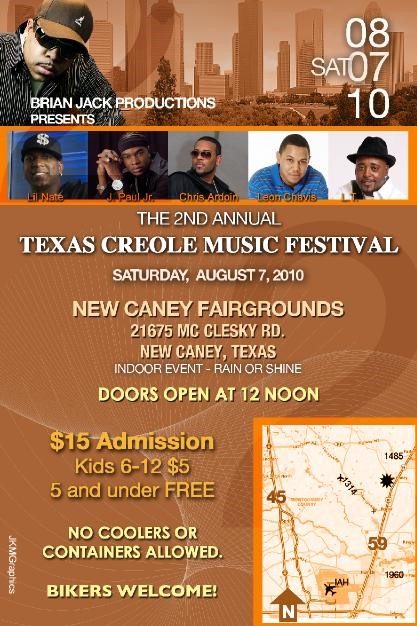 |

Stage di organetto diatonico a Maresca - Italiaby Holda Paoletti-Kampl |
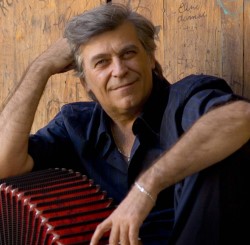 Stage di organetto diatonico con Riccardo Tesi a Maresca (PT), 18-20 agosto Stage di organetto diatonico con Riccardo Tesi a Maresca (PT), 18-20 agostoCome tutti gli anni a Maresca - sulla montagna pistoiese, nel contesto del festival Sentieri Acustici - si svolgeranno degli stage di strumento, canto e danze tradizionali. In particolare Riccardo Tesi sarà il docente dello stage di organetto diatonico. Lo stage intende offrire un panorama dei vari aspetti che caratterizzano la pratica odierna dell’organetto diatonico. Attraverso l’apprendimento di brani sia tradizionali che originali verranno presi in esame problemi sia di natura tecnica (uso del mantice, tecnica lineare ed incrociata, diteggiatura, coordinazione, ecc…) sia di natura interpretativa (ornamentazione, espressione, staccato, legato, ecc…). Ampio spazio sarà dedicato all’aspetto armonico e compositivo dello strumento e al suo utilizzo in contesti non tradizionali. Lo stage è indirizzato a strumentisti che siano già in possesso della tecnica di base. Non è richiesta la conoscenza della teoria musicale. Modello consigliato: otto bassi in Sol/Do o modelli superiori. Sono gradite apparecchiature per registrare. Lo stage si svolgerà presso la scuola elementare di Maresca da mercoledì 18 a venerdì 20 agosto dalle 9.00 alle 13.00 e sabato 21 agosto dalle 9.00 alle 11.00. Sempre sabato seguiranno delle prove libere dalle 14.30 alle 15.30 e l'esibizione finale dalle 16.00, presso Le Ginestre, a Maresca. Per altre informazioni, le modalità d'iscrizione e l'intero elenco degli stage in programma visitare il sito www.provincia.pistoia.it/sentieriacustici/ |

Jyderup Harmonikafestival - Denmarkby Holda Paoletti-Kampl |
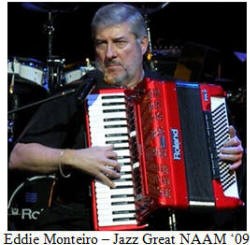 From 19-20-21-22 August 2010 From 19-20-21-22 August 2010Information e-mail: mogens.baekgaard@mail.dk Web:http://www.harmonikafestival.dk Office:Mogens Bækgaard Where: Ellebjergvej 36, Jyderup, Denmark |
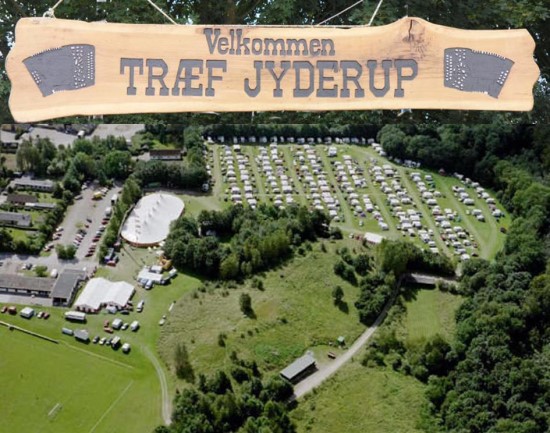 |

Dublin Irish Festival/Ohio - USAby Holda Paoletti-Kampl |
 |
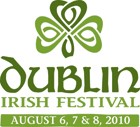 http://www.dublinirishfestival.org 6-8 August/OHIO http://www.dublinirishfestival.org 6-8 August/OHIO 2010 Entertainment on the Dublin Irish Festival Stages: Dublin Stage This Anchor stage on the North end of the Festival grounds features headline acts as well as seasoned local performers. The musicians on the Dublin Stage will perform songs and instrumentals that are rich in Irish tradition, compelling originals, sing-a-longs, and spirited fiddle tunes Celtic Rock Stage Where bagpipes rock! This anchor stage on the south end of the festival grounds is where 800 years of traditional music is blended into a rocked out sound of today.Expect a riveting mix of traditional, rock, rap and reggae and punk with roots in Irish and the energy of the ages.The crowds are large and loud and ready to dance Trinity Stage The songs and instrumentals at the Trinity Stage often tell the tale of Ireland and its people. The timeless qualities of folk classics, songs of the worker, songs of the sea and Irish culture combined with creative songwriting, strong vocals, talented instrumentalists and sometimes, a sense of humor and uproarious laughter, result in music that can touch the heart or get everyone fired up! Irish Thunder Stage Big sound, dancing feet and artistic performances. The Irish Thunder Stage features a mixture of Celtic entertainment that has an eclectic, non-traditional appeal including dance troupes, bagpipers, and uniqe Celtic entertainers. Ceili Dance Tent Dance opportunities abound for seasoned dancers, spectators, and those who wish to try a step. Talented Ceili bands delight audiences with their lively music as dancers and audience move to the beat. The Ceili Dance Tent is the place to be for Step Dancing, Ceili, Country Sets, Contra, or dance competition and performances. Celtic Music House The talent in the Celtic Music House far exceeds the expectations of this charming venue tucked in the heart of the festival grounds nestled among the trees. Here, highly talented solo and duo acts honor the folk roots of music and present the sounds in their unique fashion with a rich range of interpretation. Shamrock Pub Where the locals go! The big draw is that it’s the festival home for central Ohio’s highly talented and energetic Irish musicians. Some of Ohio's most talented musicians can be found on this stage. Whether you are looking for a rollicking pub song, or beautiful harmonies, you can find them here. This tent is almost like a family reunion for Central Ohio's strong Irish community - come and take part in it! 2010 Opening Hours Friday, Aug. 6 from 4p.m. - Midnight Saturday, Aug. 7 from 11a.m. - Midnight Sunday, Aug. 8 from 11a.m. -9p.m. All entertainment is covered under a general admission ticket into the Festival. Children 12 and under are free. Online translation ! |

Festival San Flora - Italiaby Holda Paoletti-Kampl |
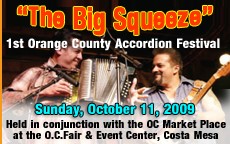 |

16° FESTIVAL DI MUSICA POPOLARE - Italiaby Holda Paoletti-Kampl |
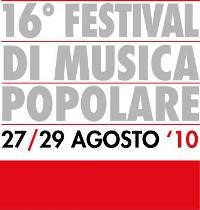 Durante i giorni di 27/28/29 AGOSTO 2010 si svolgerà a FORLIMPOPOLI il 16° FESTIVAL DI MUSICA POPOLARE. Durante i giorni di 27/28/29 AGOSTO 2010 si svolgerà a FORLIMPOPOLI il 16° FESTIVAL DI MUSICA POPOLARE.Per detagliata informazione visita il sito www.musicapopolare.net |

Future events / Concerts |

Nicht versäumen- da muss man dabei sein !!! - Austriaby Werner Weibert |
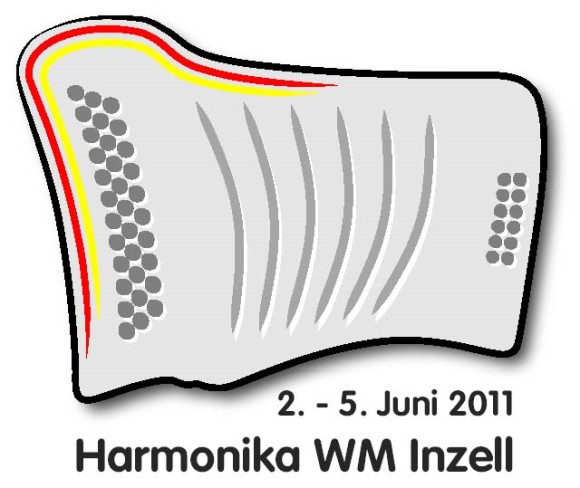 |
| Die Ausschreibung für diesen tollen Event, der diesmal in Bayern stattfindet, ist ab September 2010 unter http://www.harmonikaverband.at abrufbereit! |

Riccardo Tesi/Banditaliana Tour in August - Italy/Germanyby Holda Paoletti-Kampl |
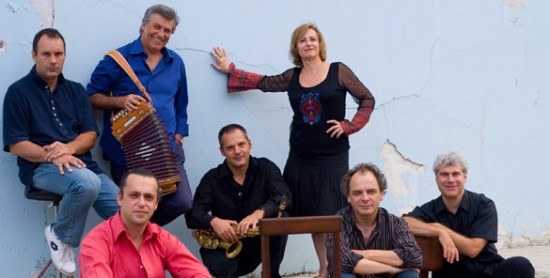 |
| 11 agosto 10 - Riccardo Tesi ospite di Uaragniaun Orkestra a Trento Per la rassegna Contrada Larga 2010, Riccardo Tesi sarà ospite della Uaragniaun Orchestra nel concerto "U Diavole e l'Acqua Sante". Il concerto si terrà a Trento, nel cortile interno di Palazzo Thun, in via Belenzani, alle ore 21.Ingresso gratuito. Altre informazioni presso il sito della manifestazione Contrada Larga, concerti sotto le stelle Sito di Uaragniaun: www.uaragniaun.com ________________________________________ 12 agosto 10 - Riccardo Tesi solo a Sarroch (Cagliari) Concerto per solo organetto di Riccardo Tesi al festival Le Notti dell'Orco si Sarroch (Cagliari).Il concerto si terrà presso il sito nuragico di Sa' D'Omu e S'Orcu. ________________________________________ 15 agosto 10 - Banditaliana a San Salvi, Firenze Torna il tradizionale concerto di Ferragosto di Banditaliana a San Salvi.Ritmo, danze e allegria per raffrescare la notte più calda dell'estate fiorentina.Inizio ore 21 ________________________________________ 19 agosto 10 - Banditaliana & Lucilla Galeazzi a Orvieto Banditaliana, ospite Lucilla Galeazzi in concerto a Orvieto, in occasione dell'Umbria Folk Festival.Il concerto, a ingresso libero, si terrà in Piazza del Popolo alle ore 22,00.Sito dell'Umbria Folk Festival: www.umbriafolkfestival.it ________________________________________ 24 agosto 10 - Banditaliana a Francoforte Trasferta in terra tedesca per Banditaliana, di scena al Palmengarten di Francoforte per la rassegna "Weltmusik im Palmengarten".Inzio concerto alle ore 19,30, ingresso 16euro. ________________________________________ 26 agosto 10 - Banditaliana a Civitella Alfadena (AQ) Banditaliana in concerto a Civitella Alfadena (AQ) per il Civitella Folk Festival. Il concerto è a ingresso gratuito e avrà inizio alle ore 22,00. ________________________________________ 27 agosto 10 - Banditaliana & Lucilla Galeazzi a Fénis (AO) Nell'ambito della rassegna di musiche tradizionali Etetrad Festival, concerto di Banditaliana, ospite Lucilla Galeazzi.Il concerto si svolgerà presso l'area Tsantì de Bouva, a Fénis, quindici chilometri da Aosta, alle ore 21,00. Ingresso gratuito. Sito internet di Etétrad Festival: http://www.etetrad.com ________________________________________ 28 agosto 10 - Banditaliana a Romagnese, in Valtidone Per il festival itinerante per la Valtidone, Up-to-Penice, concerto pomeridiano di Banditaliana a Romagnese (PV), Tenuta Penicina (in caso di maltempo presso il Centro Ippico Setteborghi).Il concerto si svolgerà alle ore 17.00. Sito del festival Up-to Penice: http://www.up-to-penice.it www.riccardotesi.it |

Le Ciaramelle d'AMATRICE/Rimini al 8 Agosto 2010 - Italiaby Holda Paoletti-Kampl |
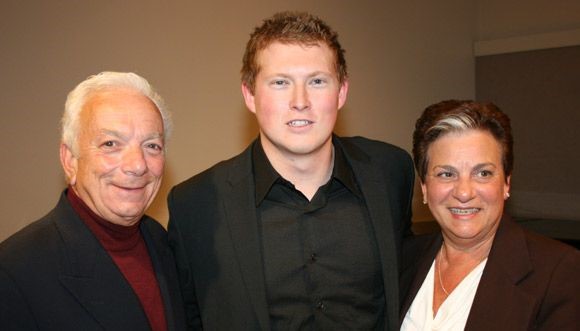 |

Musikantentreffen in Mùnchen - Deutschlandby Holda Paoletti-Kampl |
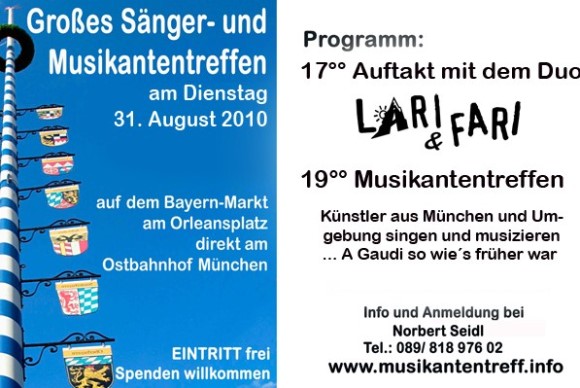 |

Majella (PE) Etno Festival 6-7 AGOSTO - Italiaby Holda Paoletti-Kampl |
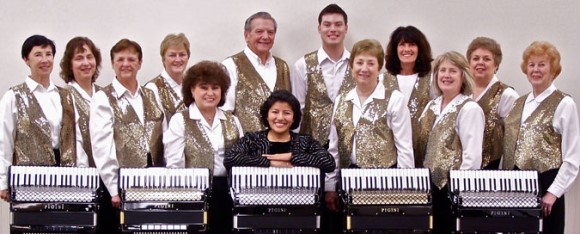 |

CD/VIDEO/Book (New/Reviews/Presentations) |

CD Release - of Austin Piazzolla Quintet - USAby Holda Paoletti-Kampl |
 Austin Piazzolla Quintet Live: CD Release!!! Austin Piazzolla Quintet Live: CD Release!!! Saturday, August 28th 9pm - 1am $10 at the door (cash or check only 9pm mini tango class Piazzolla + Traditional tango music live + DJ till 1am! The Austin Piazzolla Quintet is an Austin based tango quintet specializing in the music of renowned Argentine ango composer, Astor Piazzolla. The Quintet was founded in 2009 and includes accordionist Mike Maddux, violinist James Anderson, pianist Jonathan Geer, guitarist Adam Carney, and bassist Christina Underwood. A unique and influential composer, Astor Piazzolla boldy blends elements of classical music and jazz with his native tango - creating a fantastic sound full of melody, passion, and heart-ache. Online translation ! For furthe rinformation: |

2 CD par Yann-Fañch Perroches - Franceby Holda Paoletti-Kampl |
 |
| 1. Un "Cocktail Diato" new look pour une musique encore plus swing, plus énergique, plus festive et plus inventive que jamais ! "Quel beau voyage en voiture à six bras, neuf voix et trois soufflets ! Quand on aime, on ne compte plus les boutons, ce n'est pas la peine. Mes amis, vos accordéons et vos musiques dessinent de bien beaux paysages, remplis de landes brumeuses, de fulgurantes éclaircies dans des ciels où " les nuages crèvent comme des chiens ". Cet album vous raconte vous, votre pays, la Bretagne et tous les gens que vous y avez fait danser toutes ces années. Vous pétrissez à pleines mains une masse sonore considérable, vous ne manquez pas d'air, dans tous les sens du terme. C'est un sacré supplément de " souffle à lames ", la cerise sur le diato… des anches passent. Sacré cocktail, j'en reprendrais volontiers une petite bolée. Bravo et merci du fond du cœur." (par Marc PERRONE ) Online transation ! 2. "Diamik c'est la rencontre d'une voix et de deux accordéons, un trio riche et dynamique qui trace des lignes sur la carte au gré des influences de chacun. La voix exceptionnelle de Brigitte Kloareg ('best female singer' en 2001 à Killin en Ecosse) est accompagnée avec force et brio par deux grands de l'accordéon (Yann-Fañch Perroches au diatonique et Gwen Kijiver au chromatique) qui proposent par un jeu fluide et inspiré, une revisitation d'un répertoire que l'on croyait déjà connaître. Entre Bretagne et Poitou, les chants et les mélodies vous feront tour à tour danser, chanter et surtout vous raconteront une histoire..." (Albumtrad) Ulterieur informations: http://www.perroches.com |
 |
Help Desk, Information needed, Readers CommentsSubmit Your Question, CommentSUBMIT NOW |
Help Desk...place your question or comment ONLINE by YOURSELF - Cyberspaceby | Modify | Delete |
 |
| English Diatonic News has added a new interactive feature to the News. This is titled “Help Desk, Information needed, Readers Comments” and is situated below the News. The exciting part of this concept is that readers can list their own comments about any accordion subject they wish, ask questions, ask the accordion world for information. Its YOUR Diatonic Accordion World on www.diatonic-news.com News. Deutsch Neue interaktive Funktion auf Diatonic News! Diatonic News hat eine neue interaktive Funktion in den Nachrichten aufgenommen. Diese trägt den Titel "Help Desk, Information gesucht, Leser Kommentare" und ist am Ender der Nachrichtenausgabe positioniert. Der interessante Teil dieses Konzeptes ist, dass unsere Leser selbst auf dieser Seite akitv sein kònnen. Jeder Leser kann ab sofort online eigene Kommentare zu jedem Akkordeon Thema, generelle Fragen und Suche nach Information an die Akkordeonwelt/leser auf www.diatonic-news.com ins Netz setzen. Nehmen Sie Anspruch von dieser neuen interaktiven Mòglichkeit, die das Ziel hat, unseren Lesern eine intensivere und sofortige Kommunikation mit anderen Akkordeoninteressierten zu ermòglichen Italiano Nuova funzione interattiva su www.diatonic-news.com ! Diatonic-news ha inserito una nuova funzionalità interattiva nella sua edizione di notizie. Questa è intitolato "Help desk, informazioni, commenti dei lettori, ed è posizionata alla fine è della pagina. La parte interessante di questo concetto è la possibilità di attività da parte dei lettori di essere se stessi in questa pagina. Ogni lettore è ora disponibile online e condividere i tuoi commenti su ogni tema fisarmonica, questioni generali e la ricerca di informazioni al mondo della fisarmonica / lettori sul AWW rete. Prendete vantaggio di questa nuova opportunità interattiva che ha l'obiettivo di permettere ai nostri lettori di una comunicazione intensa e immediata con altri interessati di www.diatonic-news.com . Français Nouvelles hebdomadaires nouveaux initiés fonction interactive Diatonic News a ajouté une nouvelle fonctionnalité interactive à la Nouvelles. C'est intitulé «Help Desk, les informations nécessaires, Commentaires des lecteurs" et se situe en dessous de la Nouvelles hebdomadaires. La partie intéressante de ce concept est que les lecteurs peuvent publier leurs propres commentaires sur n'importe quel sujet accordéon elles le souhaitent, poser des questions, demander de l'accordéon monde pour l'information. Alors s'il vous plaît utiliser et de profiter de ce nouvel outil interactif, visant à permettre une plus grande communication entre les accordéonistes. 中文 “每周新闻”新增交互式特色栏目 《环球手风琴》在“每周新闻”中增加了一个新的交互式的特色栏目. 标题是“Help Desk, Information needed, Readers Comments” ,放在下面的每周新闻中. 这一理念令人兴奋的地方是读者可以加入他们自己关于手风琴主题的任何评论、提出问题、询问手风琴演出信息. 这部分内容在《环球手风琴》每周新闻的“ 你的手风琴世界 ”栏目中. 因此请你使用并欣赏这个交互式的工具, 目的是增强手风琴家之间的沟通. Русский Раздел «Еженедельные новости» инициирует новую интерактивную функциию Сайт Diatonic News добавил новую интерактивную функцию в раздел еженедельных новостей. Она озаглавлена "Доска помощи, необходимая информация, комментарии читателей" и расположена под разделом еженедельных новостей. Важной частью этой новинки является то, что читатели смогут составить список собственных комментариев по любым вопросам, касающимся аккордеона, задать вопросы, запросить информацию, касающуюся аккордеона. Это ВАШ Мир Аккордеона на сайте www.diatonic-news.com. Пожалуйста, пользуйтесь и наслаждайтесь этим новым интерактивным сервисом, направленным на достижение более тесных связей между аккордеонистами. Information: Webmaster / Online translation ! Example |
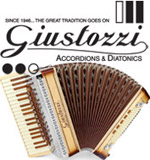
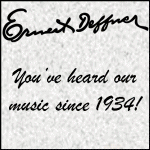
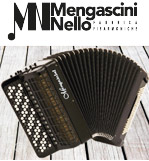
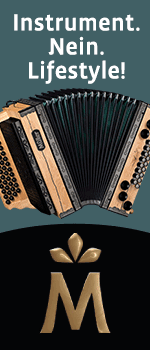

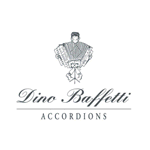
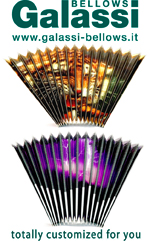




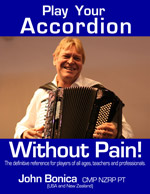

![Jacques Mornet's [non] Method Book with Video Support](http://www.accordions.com/index/squ/graphics/jmornet-en.jpg)
